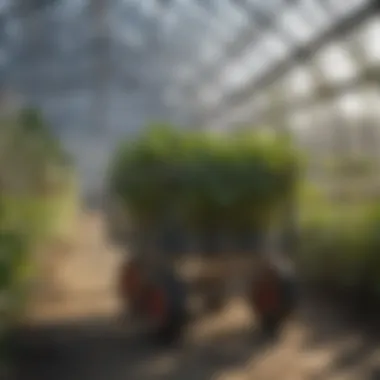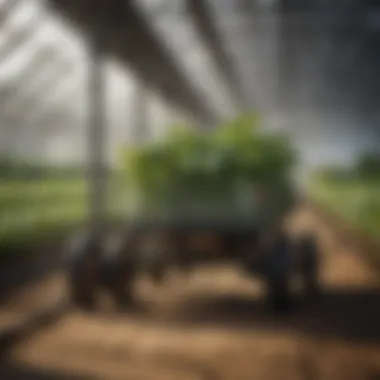Maximizing Greenhouse Efficiency with Plant Carts


Intro
In modern agriculture, efficiency and mobility play significant roles. As farms expand and diversify, the way plants are managed must evolve as well. Greenhouse plant carts have emerged as vital tools in this transformation. Their utility extends beyond mere transport; they enhance productivity, streamline plant care processes, and foster better agricultural practices. This article explores the various aspects of greenhouse plant carts in detail, emphasizing their importance in contemporary farming.
Overview of the Topic
Definition and Importance
Greenhouse plant carts are specialized vehicles designed for the effective movement of plants and related materials within greenhouse environments. They facilitate easy access to plants, ensuring better care and management. The importance of these carts cannot be overstated. With efficient plant handling, they directly contribute to improved growth conditions and higher yield rates. Greenhouse plant carts streamline workflows and minimize the labor intensity required in plant management tasks.
Current Trends
Recent trends indicate a shift towards more ergonomic and specialized designs tailored for specific greenhouse operations. Manufacturers focus on lightweight materials that make carts easy to maneuver. The integration of technology, such as automated carts, is also gaining traction. These advancements are paving the way for smarter farming practices. Additionally, sustainability concerns are influencing the selection of materials used in constructing these carts, further enhancing their adoption in eco-conscious farming.
Key Techniques and Practices
Step-by-Step Guide
- Assess Your Needs: Evaluate the size of your greenhouse and the types of plants you manage. This assessment will inform your cart selection based on capacity and dimensions.
- Choose the Right Design: Select from various cart designs that suit your specific tasks. Options include shelving carts for potted plants and utility carts for transporting tools and supplies.
- Regular Maintenance: Implement a maintenance routine that includes checking wheels, brakes, and surfaces. This practice ensures longevity and continuous performance.
Tools and Equipment Needed
- Greenhouse plant carts in various designs.
- Cleaning supplies for maintenance.
- Safety equipment, such as gloves and protective eyewear, during handling.
Challenges and Solutions
Common Obstacles
Despite their advantages, several challenges may arise in the use of greenhouse plant carts. One issue is space constraints within smaller greenhouses, making mobility difficult. Another challenge is bulkier loads that require more strength and stability.
Innovative Solutions
To tackle these challenges, innovative solutions have been implemented. Compact cart designs help navigate tighter spaces. Additionally, adjustable shelving within carts allows for flexibility in load management. Recognizing the limitations and utilizing solutions can lead to enhanced operational effectiveness within the greenhouse setting.
"Efficient design and use of greenhouse carts can significantly improve productivity and plant health in agricultural operations."
Foreword to Greenhouse Plant Carts
In modern agriculture, greenhouse plant carts have emerged as indispensable tools, facilitating efficient workflows and ensuring the health of plants. These carts are not merely for transportation; they are integral to improving productivity and supporting various gardening tasks. Their value becomes evident when considering how they streamline movement within a greenhouse environment, allowing for the organization of plants and equipment in a systematic manner.
Definition and Purpose
Greenhouse plant carts, as the name suggests, are specifically designed vehicles used in greenhouse operations. They come in various types, tailored for distinct functions. Generally, their purpose is to transport plants, soil, tools, and other materials across the greenhouse. This mobility is crucial when managing space effectively, particularly in larger settings where the distance between tasks can hinder usability. The carts are designed to enhance ease of movement while ensuring delicate plants can be transported without risk of damage.
Historical Context
The utilization of carts in agricultural settings has a long history. Traditionally, farmers used basic carts made of wood or metal to transport goods in their fields. As greenhouse technology evolved, so did the carts. The introduction of materials such as plastic and aluminum marked a significant advancement. These new materials offers advantages like durability and lightweight properties. In recent years, the design of greenhouse carts has further improved due to technological innovations aimed at enhancing mobility and user experience. Wheeler designs have adopted modern engineering principles to provide stability, ensuring that plants remain undisturbed during transport. This continued evolution illustrates the growing understanding of the role mobility plays in efficient greenhouse management.
Types of Greenhouse Plant Carts
The variety of greenhouse plant carts available in the market serves an essential role in modern agricultural practices. Each type of cart offers unique benefits and features that cater to specific tasks and workflows within the greenhouse environment. Understanding these types can significantly enhance productivity and ease of use.
Flatbed Carts
Flatbed carts are recognized for their simplicity and versatility. Designed with a flat, open surface, these carts enable easy placement and transport of a wide array of items, from pots to bags of soil. The open flat design provides flexibility for loading and unloading, making it ideal for moving bulk materials around the greenhouse.
The strength of flatbed carts lies in their adaptability. They can accommodate various sizes and shapes of items without restrictions. Additionally, they often come with sturdy wheels suitable for uneven surfaces, ensuring smooth movement across the greenhouse floor. For easy storage, many flatbed carts are stackable.
Shelved Carts
Shelved carts elevate the concept of cart design to organize and optimize space efficiently. These carts feature multiple shelves, providing designated areas for different plant varieties or tools. This structure not only maximizes vertical space but also enhances the accessibility of items.
The advantages of using shelved carts include increased organization and reduced searching time. With items spaced out on shelves, farm professionals can easily locate what they need. Such carts often have safety features like edge barriers to prevent items from falling off while in transit, adding an extra layer of reliability.


Utility Carts
Utility carts are designed with flexibility in mind, targeted towards various tasks within the greenhouse. These carts often combine features from flatbed and shelved designs, making them suitable for transporting both small and large items. Their design typically includes side panels, helping to prevent items from falling off during movement.
Furthermore, utility carts may come with additional features like foldable sides for compact storage or adjustable heights, making them more user-friendly in different scenarios. They are useful for carrying tools, plants, and even waste materials, supporting overall greenhouse hygiene.
"Choosing the right type of cart is crucial for enhancing workflow efficiency and moving materials effectively in the greenhouse environment."
In summary, each type of greenhouse cart serves specific purposes and is designed to improve efficiency in various tasks. Understanding these differences allows agricultural professionals to select the most suitable options for their needs, ultimately leading to more effective greenhouse management.
Design Considerations for Greenhouse Carts
In the realm of modern agriculture, the role of greenhouse plant carts cannot be overstated. When it comes to optimizing their use, several important design considerations emerge. These elements not only enhance functionality but also ensure that the carts effectively support greenhouse management practices. Therefore, this section will delve into material selection, size and capacity, as well as wheel design and mobility.
Material Selection
Choosing the right materials for greenhouse carts is fundamental. The durability of materials directly affects the cart's lifespan and its ability to withstand various greenhouse conditions. Materials like aluminum, stainless steel, and high-density polyethylene are popular for their resistance to moisture, corrosion, and temperature fluctuations. Each of these materials presents unique advantages:
- Aluminum is lightweight, making carts easy to maneuver.
- Stainless steel offers high durability and is often used in commercial settings where robustness is vital.
- High-density polyethylene is resistant to chemicals and offers good impact resistance.
The choice of material can also influence maintenance practices. For instance, carts made of materials that are easy to clean helps maintain hygiene in the growing environment. Thus, selecting the right material can lead to better long-term performance and reduced maintenance costs.
Size and Capacity
The dimensions and load capacity of greenhouse carts play a crucial role in their effectiveness. A cart that is appropriately sized allows for efficient movement through aisles and reduces the risk of damaging plants or infrastructure.
Key considerations include:
- Aisle Width: Carts must fit comfortably in the available space without hindering movement.
- Load Capacity: Depending on the volume of plants or materials being transported, capacity should align with the intended use. This ensures that the cart can handle the weight without buckling or causing accidents.
- Ergonomics: The height of shelves and handles should be designed to minimize strain on the user, especially during long periods of use.
Selecting the right size and capacity aligns with enhancing workflow efficiency and prevents operational inefficiencies that can arise from using ill-fitted carts.
Wheel Design and Mobility
The design of wheels on greenhouse carts significantly affects mobility and ease of use. Swivel casters can be advantageous as they facilitate easy turning, making it simpler to navigate tight spaces. Additionally, wheel size impacts the cart's stability and its ability to roll over uneven surfaces.
Considerations for wheel design include:
- Material: Rubber wheels are ideal for indoor environments, providing smooth movement and reducing noise.
- Size: Larger wheels can better negotiate obstacles and uneven ground, which can be common in greenhouses.
- Brakes: Adding a braking mechanism to wheels ensures safety when carts are stationary, particularly on sloped surfaces.
A well-designed wheel system improves not only user experience but also contributes to the overall effectiveness of greenhouse operations. By facilitating easy transport of plants or materials, the design of wheels can have a significant impact on productivity and worker satisfaction.
Considering these design aspects will significantly enhance the efficiency and functionality of greenhouse plant carts, making them indispensable in modern agricultural setups.
Integrating Carts into Greenhouse Management Practices
Integrating carts into greenhouse management practices is essential for optimizing operational efficiency and improving overall plant care. This integration goes beyond mere convenience; it offers concrete benefits that contribute significantly to the productivity of greenhouse operations. By utilizing the right carts, growers can manage their workflow more effectively, minimize time spent on manual tasks, and enhance the overall care of their plants. This section explores specific methods to achieve these outcomes, focusing on enhancing workflow efficiency and optimizing space utilization.
Enhancing Workflow Efficiency
One crucial aspect of integrating carts into greenhouse management is enhancing workflow efficiency. Properly designed and well-utilized carts can streamline operations by allowing staff to move plants, tools, and supplies seamlessly. For instance, flatbed carts facilitate easy transportation of bulk items while utility carts are perfect for smaller tools and materials. This increased mobility enables workers to shift their focus from labor-intensive tasks to more strategic activities like monitoring plant health and optimizing growth conditions.
Additionally, having the right cart in the proper location reduces travel time significantly. Instead of making frequent trips back and forth to storage areas, workers can keep essential items within arm's reach. This setup not only minimizes fatigue but also promotes a more organized workspace.
Through thoughtful integration of carts into daily routines, greenhouse operators can observe rapid improvements in productivity metrics and job satisfaction among staff. Workers can delegate tasks more efficiently, and roles can be assigned based on cart availability and specific needs.
Optimizing Space Utilization
Another significant benefit of integrating carts into greenhouse management is optimizing space utilization. Limited space is often a challenge in many greenhouse settings, making it essential to utilize every available inch effectively. Carts designed with various shelves or compartments can aid in organizing tools, pots, and nutrient solutions, helping to maintain an orderly workspace without clutter.
The right cart can also facilitate vertical gardening or staggering plant heights. For example, shelved carts allow for plants to be tiered, freeing up ground space and enabling better air circulation and light exposure. This is particularly useful in high-density growing systems where maximizing available area is a key component of success.
Additionally, well-organized carts can also make it easier to categorize plants based on growth stage or environmental needs. By keeping similar plants together, growers can monitor their status more efficiently and implement care strategies more effectively.
Integrating carts into greenhouse management is not merely about transportation; it profoundly influences workflow and space management. By enhancing operational efficiency and optimizing space, greenhouse managers can ensure that their practices remain sustainable and productive in the ever-evolving agricultural landscape.


Maintenance and Care for Greenhouse Carts
Maintaining greenhouse plant carts is essential for ensuring their longevity and proper functioning. Since these carts play a vital role in transporting plants, tools, and materials within the greenhouse, a regular maintenance routine can significantly impact overall efficiency in greenhouse management. In this section, we will explore the importance of maintenance and care, emphasizing specific elements, benefits, and considerations regarding greenhouse carts.
Regular Inspection Protocols
Regular inspections of greenhouse carts are crucial. These inspections should focus on various components, such as wheels, handles, and structural integrity. It is advisable to check for signs of wear and tear, including rust on metal parts or cracks in plastic components. A simple checklist can be established:
- Wheels: Inspect for damage and ensure they roll smoothly.
- Frame: Look for any bending or breaking. This affects how much weight the cart can carry.
- Handles: Ensure they are secure and not wobbling.
- Surface: Check for rough spots or sharp edges that may harm plants or users.
Timely detection of issues during inspections can prevent costly repairs or replacements later. The key is to have a scheduled inspection, maybe bi-weekly, to maintain an optimal working condition for all carts.
Cleaning and Sanitization
Cleaning and sanitizing plant carts is another significant aspect of maintenance. This process ensures that any soil, pests, or pathogens do not transfer between different plant batches. To maintain a clean environment, adopt the following practices:
- Remove Debris: Start by removing any leftover soil, plant matter, or trash from the cart.
- Wash with Soap and Water: Use a mild detergent to wash all surfaces thoroughly. Avoid harsh chemicals, as they can negatively affect plants.
- Sanitize: After cleaning, a diluted bleach solution or an environmentally-friendly sanitizer should be applied to kill any pathogens. Rinse well to ensure no residual chemicals remain.
- Drying: Allow the cart to air dry completely before using it again. This step helps prevent mold or mildew buildup.
Implementing a proper cleaning routine not only promotes good hygiene but also prolongs the life of the cart. A clean cart enhances mobility and reduces plant stress, leading to healthier growth overall.
"Regular maintenance not only increases the lifespan of greenhouse carts but also enhances overall efficiency in managing greenhouse operations."
By establishing regular inspection protocols and cleaning routines, greenhouse managers can ensure their plant carts remain effective tools in modern agricultural practices. Proper care creates a safer, healthier environment for plant cultivation.
Impacts on Plant Health
The role of greenhouse plant carts in promoting plant health is a pivotal aspect of modern agricultural practices. These carts significantly influence plant growth conditions, ensure plants thrive, and enhance overall productivity. Understanding these impacts helps farmers and greenhouse operators make informed decisions about their operations.
Mobility and Accessibility
Mobility is a crucial factor when dealing with plants in a greenhouse. Greenhouse plant carts allow for easy relocation of plants and materials. This accessibility can greatly affect how efficiently tasks are completed. For instance, with the right cart, workers can move multiple trays of seedlings or pots simultaneously. This not only saves time but also reduces the physical strain on workers, allowing them to direct more focus on caring for the plants.
Moreover, carts can reach areas in the greenhouse that might be otherwise challenging to access. This is particularly important in larger setups where walking distances can be considerable. If a cart can easily navigate tight spaces, it increases the frequency with which plants can be monitored and tended to. Ensuring that each plant receives timely care can lead to healthier, more robust growth.
Minimizing Plant Disturbance
Plant disturbance is a significant concern in greenhouse management. Every time plants are moved, they can experience stress, which can hinder their growth. Greenhouse plant carts are designed to minimize this disturbance. With features such as soft bedding or custom trays, these carts help to stabilize plants during movement, reducing the risk of damage.
Furthermore, using proper carts can help maintain consistent environmental conditions for the plants. For instance, if plants are frequently moved from one area to another, fluctuations in temperature and humidity can occur. This inconsistency proves detrimental to delicate species.
In summary, utilizing greenhouse plant carts effectively can promote optimal plant health. Their design allows for easy mobility while reducing the stress associated with relocating plants. By enhancing accessibility and minimizing disturbances, these carts prove invaluable in maintaining a healthy growing environment.
By investing in the right type of greenhouse plant carts, farmers can significantly improve their plant care practices, leading to better yields and healthier crops.
Case Studies and Practical Applications
The practical aspects of greenhouse plant carts are not merely theoretical; they find considerable relevance in both small and large-scale agricultural settings. By examining case studies and real-world applications, we can assess how these tools provide tangible benefits. This section highlights various situations where greenhouse carts enhance operational efficiency, demonstrating their importance in modern agriculture.
Small-Scale Greenhouses
Small-scale greenhouses, often operated by individual farmers or hobbyists, rely heavily on efficiency and mobility. For these operators, effective use of greenhouse plant carts can significantly impact day-to-day operations.
For example, a farmer in a small region of the Midwest utilizes a flatbed cart to transport seedlings from the germination area to the planting beds. This cart allows for the easy movement of trays without the need for multiple trips. The result is faster planting times and reduced labor fatigue.
Key benefits of using a cart in small-scale applications include:
- Increased Mobility: Carts allow farmers to move plants quickly between sections of the greenhouse, promoting better workflow.
- Enhanced Organization: Using carts helps in organizing tools and plants systematically, reducing chaos.
- Time Efficiency: Reduces the manual handling of plants, which can lead to faster turnaround times during planting seasons.
Commercial Greenhouses
In commercial settings, where scale and efficiency are paramount, greenhouse plant carts play a more complex role. For instance, a large commercial facility in California employs several types of carts—shelved and utility carts—to streamline operations across multiple departments.
Daily operations include transporting plants, tools, and other supplies necessary for maintaining a large greenhouse. For this purpose, the business uses two-wheeled utility carts to move larger items and shelved carts to carry delicate potted plants. Such diversification ensures that every logistical need is met without delays.
Benefits observed in commercial greenhouse setups are:


- Operational Synergy: Different cart types work together, allowing for efficient usage in varied tasks.
- Reduced Plant Damage: Specialized carts minimize disturbances to the plants during transportation.
- Scalability: As production increases, the use of carts can be adjusted to meet higher demands without significant changes to existing workflows.
"The implementation of greenhouse plant carts has revolutionized our operation. We can now serve more customers without sacrificing quality."
This stark contrast between small and commercial operations highlights the flexibility and adaptability of greenhouse plant carts across different scales. Both types of greenhouse operations benefit from improved efficiency and reduced labor, proving their value as indispensable tools in modern agriculture.
Comparative Analysis: Carts vs. Traditional Methods
Greenhouse plant carts have gained increasing attention in agricultural practices due to their utility and efficiency compared to traditional methods of transport and organization within greenhouses. Understanding this comparative analysis allows agricultural professionals to effectively evaluate the advantages of utilizing carts over older methods, such as manual handling and the use of simple trays or buckets. By looking closely at efficiency metrics and cost-benefit analysis, we can appreciate the significant role carts play in modern agricultural settings.
Efficiency Metrics
Efficiency in greenhouse operations is vital for maximizing outputs. Plant carts contribute to increasing efficiency by allowing for a more organized workflow. They enable workers to move multiple plants or supplies in a single trip, reducing the number of trips needed in comparison to traditional methods. Carts can carry larger volumes and weights, thus improving transportation times within the greenhouse.
Additionally, the design of these carts often includes features such as adjustable shelving and sturdy frames which make loading and unloading easier and faster. This increased mobility directly impacts labor productivity, as tasks can be completed more rapidly.
Some specific efficiency metrics include:
- Reduction in Labor Hours: Workers spend less time moving materials or plants, allowing them to focus on more critical tasks such as plant care and monitoring.
- Increase in Plant Capacity Handling: Carts can often hold more plants at once than traditional methods, thereby streamlining operations.
- Improved Space Utilization: With better organization of greenhouse space provided by carts, growers can maximize their available area, leading to higher yields per square foot.
Cost-Benefit Analysis
Evaluating the cost versus the benefits of greenhouse plant carts involves assessing both the initial investment and the ongoing savings they provide. The upfront cost of quality carts can be justified when one considers the factors of reduced labor costs and increased productivity.
- Initial Investment: Greenhouse plant carts can vary in price based on their design and material. While the initial outlay may be significant, it is essential to see this as a long-term investment.
- Labor Savings: As mentioned previously, by enhancing the ability to transport multiple items at once, these carts lead to significant reductions in labor costs. Staff can handle more plants or supplies in a given timeframe, reducing the need for additional workers.
- Durability and Maintenance: High-quality carts typically result in lower maintenance costs over time due to their robust construction. This can result in fewer replacements and repairs, further adding to their overall cost-effectiveness.
"Carts provide a considerable advantage in reducing the workload and enhancing the efficiency of greenhouse operations against conventional handling methods."
Emerging Trends in Greenhouse Carts
The landscape of greenhouse management is undergoing significant changes, largely driven by innovations and emerging trends in greenhouse plant carts. These trends play a crucial role in enhancing the efficiency of farming practices. By recognizing and adapting to these shifts, agricultural professionals can improve productivity, optimize resource usage, and ensure sustainability in their operations.
Technological Innovations
One of the most prominent trends is the infusion of technology into greenhouse plant cart designs. This includes the integration of smart features such as automated lifting mechanisms, sensor-guided navigation, and even data collection capabilities. These innovations are not merely enhancements; they offer substantial benefits to farmers.
- Automated lifting mechanisms reduce physical strain on workers, ensuring better ergonomic practices.
- Sensor-guided navigation helps in precise movement and placement, minimizing accidental damage to vulnerable plants.
- Data collection capabilities enable better tracking of plant health and environmental conditions.
By incorporating advanced technologies, greenhouse carts can now contribute to a more data-driven and efficient approach in modern agriculture.
Sustainability Considerations
In addition to technological advancements, sustainability remains a fundamental aspect of emerging trends in greenhouse carts. The agricultural sector faces mounting pressure to adopt eco-friendly practices. Carts designed with recycled materials or that can be easily repaired align well with these sustainability goals. Here are some considerations:
- Material Selection: Many manufacturers are now focusing on using sustainable, durable materials for cart construction. This might include recycled plastics or metals that ensure long-lasting use.
- Energy Efficiency: Electric or hybrid-powered carts are gaining traction. Not only do they reduce fossil fuel usage, but they also decrease carbon emissions in greenhouse operations.
- Life Cycle Assessment: Many producers are now analyzing the ecological impact of their carts from production through disposal. This informs a shift towards sustainable practices that extend beyond mere compliance.
To summarize the importance of these trends, it is clear that the evolution of greenhouse plant carts directly reflects a commitment to efficiency and sustainability in agricultural practices. As both farmers and consumers demand more from the food industry, being at the forefront of these trends will be essential for future success.
"The right tools not only improve efficiency but also empower a sustainable approach towards agriculture."
By staying informed about these emerging trends, agricultural practitioners can leverage these advancements for enhanced operational productivity and responsible farming practices.
Finale and Future Perspectives
The conclusion of this article on greenhouse plant carts serves as a vital junction where all insights converge. The significance of adopting these carts in modern agricultural practices cannot be overstated. They offer substantial improvements in efficiency, plant health, and overall management of greenhouse environments.
In summary, greenhouse plant carts enable easier mobility of plants and materials. This leads to time savings and reduces labor intensity. Furthermore, the right cart can aid in maintaining plant integrity and health during transportation within the greenhouse. Consequently, the integration of plant carts into everyday operations enhances productivity.
As agricultural practices evolve, there is an increasing need to embrace innovative solutions. The future of greenhouse plant carts is promising. As professionals explore new designs and functions, the potential for enhanced features such as automation and smart technology integration seems likely. These advancements could transform traditional practices by increasing precision and reducing human error.
Summary of Key Findings
- Efficiency Gains: Incorporating greenhouse plant carts significantly shortens the time and effort required for tasks such as planting, harvesting, and relocation of plants.
- Improved Plant Care: The use of specialized carts minimizes disruption to root systems, thus enhancing overall plant health.
- Versatility: Various cart types exist to meet diverse operational needs, ensuring that every greenhouse can find a suitable model.
- Maintenance Simplicity: Basic care and upkeep of carts can extend their lifespan and maintain their efficiency over time.
Potential Developments in Cart Design and Functionality
The landscape of greenhouse plant carts is ripe for innovation. Some potential future developments include:
- Smart Carts: Integration of sensors to monitor plant conditions during transit could provide real-time data, aiding in decision-making.
- Eco-Friendly Materials: As sustainability becomes a priority, the use of biodegradable or recycled materials in cart construction may emerge.
- Automated Systems: Carts that utilize robotics for autonomous movement could revolutionize the way plants are handled in greenhouses.
As trends continue to shift, the attention to advancing technologies and sustainability practices is crucial. Adapting to these changes will not only benefit plant health but also align greenhouse operations with ecological goals. The future holds vast potential for greenhouse plant carts and their evolving role in agriculture.



